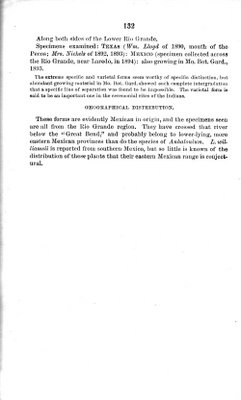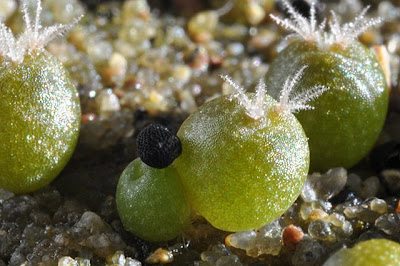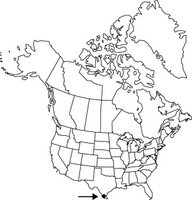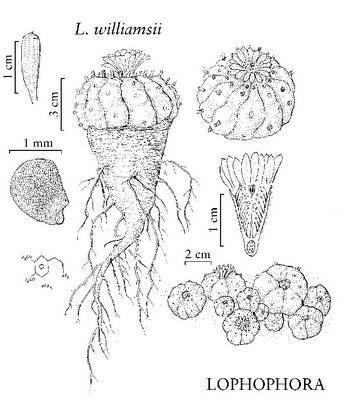by John M. Coulter
U. S. Department of Agriculture
Division of Botany
CONTRIBUTIONS FROM THE U. S. NATIONAL HERBARIUM
Vol. III--No. 2
Issued June 10, 1894
LOPHOPHORA, gen. nov.
Depressed-globose, proliferous and cespitose, tuberculate-ribbed,
unarmed plants: tubercles at first conical and bearing at summit
a flower-bearing areola with a dense tuft or short pencil of
compact erect hairs, when mature becoming broad and rounded (with
the remnant of the penicellate tuft as a persistent pulvillus in
a small central depression) and coalescing into broad convex
vertical ribs: spine bearing areolae obsolete: flowers borne at
the summit of nascent tubercles: ovary naked (that is free from
scales, but often downy): fruit and seed unknown.
These forms have been variously referred to
Anhalonium and
Echinocactus, but seem to deserve generic distinction. They
differ from
Anhalonium in the entire suppression of the upper
highly differentiated portion of the tubercle, in the broad and
rounded development of the lower portion, and in the coalescence
of the enlarged tubercles into broad vertical ribs. In fact, in
young specimens, the plant appears almost smooth, with shallow
furrows radiating from the depressed apex. The genus differs
from
Echinocactus in the suppression of the spine-bearing
areolae, and the naked ovary. In the examination of developing
tubercles the relation to
Anhalonium is evident. In the latter
genus the young tubercle bears on the summit of its pedicel-like
lower portion the tufted flower-bearing areola the modified upper
portion of the tubercle at that time appearing as a bract beneath
the flower. In
Lophophora there is the same condition of things,
except that the bract-like upper portion is wanting. From this
point of view it would appear that the differences between
Lophophora and
Echinocactus are intensified by the fact that the
flower-bearing areola in the former genus is to be regarded as
really lateral on a tubercle the upper part of which has
disappeared. This genus occurs abundantly in southeastern Texas,
extending southward into Mexico. Mrs. A. B. Nickels reports that
the Indians use the plants in manufacturing an intoxicating
drink, also for "breaking fevers," and that the tops cut off and
dried are called "mescal buttons."
1. Lophophora williamsii (Lem).
Echinocactus williamsii Lem. Allg. Gart. Zeit. xiii. 385 (1845).
Anhalonium williamsii Lem. in Forst Handb. Cact. i. 233 (1846).
Hemispherical, from a very thick root, often densely proliferous,
transversely lined below by the remains of withered tubercles:
ribs usually 8 (in young specimens often 6), very broad,
gradually merging above into the distinct nascent tubercles which
are crowned with somewhat delicate pencillate tufts, which
become rather inconspicuous pulvilli on the ribs: flowers small,
whitish to rose: stigmas 4. (
Ill. Bot. Mag. t. 4296) - Type
unknown.
Along the Lower Rio Grande, Texas, and extending southward into
San Luis Potosi and southern Mexico.
Specimens examined: Texas (Mrs. Nickels of 1892): San Luis
Potosi (Eschanzier of 1891): also growing in Mo. Bot. Gard. 1893.
2. Lophophora williamsii lewinii (Hennings).
Anhalonium lewinii Hennings, Gartenflora, 410 (1888).
A much more robust form, with more numerous (usually 13) and
hence narrower and more sinuous ribs, and much more prominent
tufts. (Ill. Monats. Kakteenkunde, October, 1891) - Type unknown.
Along both sides of the Lower Rio Grande.
Specimens examined: Texas (Wm. Lloyd of 1890, mouth of the
Pecos; Mrs. Nickels of 1892, 1893): Mexico (specimen collected
across the Rio Grande, near Laredo, in 1894): also growing in
Mo. Bot. Gard., 1893.
The extreme specific and varietal forms seem worthy of specific
distinction, but abundant growing material in Mo. Bot. Gard.
showed such complete intergradation that a specific line of
separation was found to be impossible. The varietal form is
said to be an important one in the ceremonial rites of the
Indians.
GEOGRAPHICAL DISTRIBUTION.
These forms are evidently Mexican in origin, and the specimens seen
are all from the Rio Grande region. They have crossed that river
below the "Great Bend," and probably belong to lower-lying, more
eastern Mexican provinces than do the species of
Anhalonium.
L. williamsii is reported from southern Mexico, but so little is
known of the distribution of these plants that their eastern
Mexican range is conjectural.
The above text is based on scanned pages from the
Contributions from the United States National Herbarium Vol. III. The scans are included below and are courtesy of the
Botanicus Digital Library,
Missouri Botanical Garden.
High-resolution copies of the scans can be found in the
files section of the
Lophophora Google group.



The first illustration of peyote appeared in
Curtis's Botanical Magazine in 1847 (plate 4296).
Back to
online articles.







































